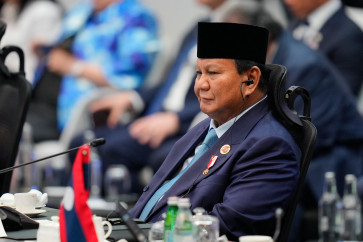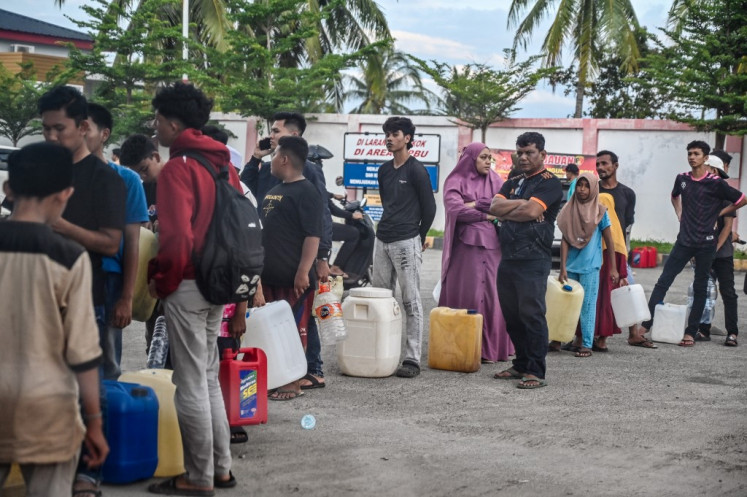Popular Reads
Top Results
Can't find what you're looking for?
View all search resultsPopular Reads
Top Results
Can't find what you're looking for?
View all search resultsForest conversion, poaching at Manusela kill rare Seram cockatoo
The Seram cockatoo (Cacatua moluccensis), an endemic bird species found mainly on the islands of Seram, Haruku, Saparua and Ambon, Maluku, is on the verge of extinction due to widespread poaching and forest clearing, a conservationist says
Change text size
Gift Premium Articles
to Anyone
T
he Seram cockatoo (Cacatua moluccensis), an endemic bird species found mainly on the islands of Seram, Haruku, Saparua and Ambon, Maluku, is on the verge of extinction due to widespread poaching and forest clearing, a conservationist says.
In the 1990s there were more than 1,000 Seram cockatoos in the wild on Seram island, but now this number has dwindled to 400, and the bird is increasingly endangered on the other three islands, Manusela National Park chief Supriyanto said.
"Besides poaching, the bird is threatened because of a loss of habitat from forest clearing. It not only lives in national park areas but also in farmland which were once forested," he told The Jakarta Post recently at his office in Masohi, Central Maluku.
Supriyatno said it was difficult to differentiate between private land and national parks in Seram because many forested areas were privately owned.
"Many farm owners have felled large trees to make way for cacao, nutmeg and clove farms. The condition has had an adverse impact on the population of the cockatoo, not to mention poaching," he said.
While it is protected by the 1990 law on the conservation of natural resources and ecosystems, the rare orange-crested cockatoo remains subject to poaching for illegal trade.
According to ProFauna Indonesia conservation group, at least 1,000 Seram cockatoos were poached and traded in Jakarta between December 2003 and May 2004.
"The poaching rate has dropped now because we have rebuilt three of the five observation posts that were destroyed by fire in the Maluku riots. We have also empowered local communities as rangers for the Wildlife Rehabilitation Center (PRS) to reduce poaching in the area.
"There are still instances of poaching, but the frequency has declined," Supriyanto said.
The 1990 law clearly stipulates that those involved in the trade of protected wildlife, such as the Seram cockatoo, are liable to a 5-year prison sentence and a Rp 100 million (US$9,132) fine.
"We at the national park, are committed to reducing the poaching rate of this bird species," Supriyanto said.
To overcome the poaching and forest clearing, Manusela National Park has developed an effective strategy by involving traditional communities -- who once hunt down cockatoos and other wildlife for meat -- as PRS rangers in and around the park.
"We will maintain the large trees that serve as cockatoo habitat by involving villagers and farm owners as wardens.
"Besides receiving salaries, they can also earn extra income by serving visitors as guides for tracking and bird observation in the park," Supriyatno said, adding that the activities would have a positive impact on the wildlife in and around the park.
Manusela National Park, which covers some 189,000 hectares, is also home to a number of other endemic wildlife species, including a variety of rodents, the slow loris (Spilocuccuc maculates), black-crested parrots (Lorius domicella), Raja or king parrot (Alisterus amboinensis), the casuary (Casusricus casuarius) and Seram gecko.
The park also contains 24 tree, 120 fern, 100 moss and 96 orchid species.
Supriyanto said the park, which presents the Seram cockatoo as its mascot, receives around 150 visitors annually, mostly from the Netherlands and the United States.
The foreign visitors usually come for tracking and bird watching which they can do from atop a number of towers (up to 30 meters high) around the park, from where they can watch more than 20 bird species daily.
Visitors arriving at the Pattimura Airport in Ambon must take a two-hour speedboat ride from Tulehu village (east of Ambon island) to Masohi, Central Maluku, and then another four-hour overland journey by car to reach Manusela's front gates in North Seram.










